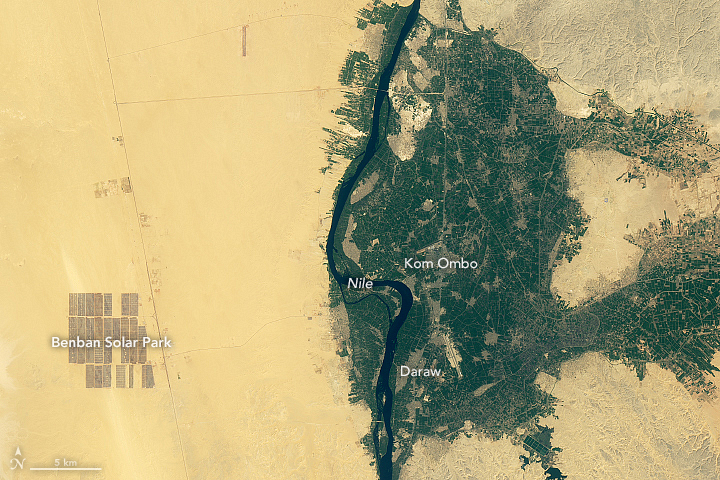

Egypt has plenty of oil and gas supplies underground. It also has an abundance of clear skies and sunlight. In 2019, the nation harnessed some of that energy with one of the largest solar energy installations in the world.
In Aswan province, about 650 kilometers (400 miles) south of Cairo, the $4 billion Benban Solar Park has sprung up from the desert. When finished, it will cover about 37 square kilometers (14 square miles) with more than 7 million photovoltaic solar panels. It is Egypt’s first utility-scale solar power facility, and it is projected to have the capacity to produce 1.8 gigawatts of electricity.
The natural-color images above were acquired by the Operational Land Imager on Landsat 8. The first shows Benban Solar Park on June 16, 2018, not long after the first sections went online. The second image shows the same area on October 9, 2019, when the solar park was about 80 percent complete. The wider view below shows the proximity to the Nile River and the towns of Kom Ombo and Daraw.
The drive for solar and other renewable power sources is more than a clean energy movement for Egypt. Five years ago, the nation’s peak electricity demand was 28 gigawatts (GW), while its production was just 24 GW. Blackouts were common. With 96 million people and a growing population and economy, Egypt projects that it will need to double its electric power capacity, which it is doing through a blend of solar, hydroelectric, and natural gas plants.

At the start of 2018, Egypt drew about 90 percent of its electricity from oil and natural gas. By the end of 2022, the nation hopes to raise renewable energy sources to 20 percent of domestic production. They intend to get to 42 percent by 2035.
The Benban Solar Park was developed through an interesting model. The area was divided up into 41 plots of varying sizes, and plots were assigned to roughly 30 developers who have been installing solar panels, transformers, and other hardware on their parcels. They will produce and sell energy back to the national utility. Roads and infrastructure—including connections to the power grid—were built by the state-owned Egyptian Electricity Holding Company, and many projects had funding from international power companies, the International Finance Corporation, and the World Bank.
Solar power in the desert brings some challenges. According to IEEE Spectrum, extremely high temperatures can sometimes damage inverters, which convert the DC power made by the photovoltaics into the AC power needed for the grid. Dust and sandstorms also can reduce the sun-collecting capacity of the panels, so specially-designed tractors will brush off the surfaces a few times a month.
NASA Earth Observatory images by Lauren Dauphin, using Landsat data from the U.S. Geological Survey. Story by Mike Carlowicz.